Tucked away in the eastern Tibetan Plateau lies Siguniang Mountain. This “Four Sisters Mountain” is one of China’s best-kept secrets. Often called the “Oriental Alps,” it features breathtaking alpine scenery. Visitors marvel at its jagged peaks, pristine valleys, and turquoise lakes.
The area is a UNESCO World Heritage site within the Giant Panda Habitats. It boasts incredible biodiversity and dramatic landscapes. Rich Tibetan and Qiang cultural heritage adds to its appeal.
Whether you’re a photographer seeking perfect landscapes, a casual hiker wanting to experience alpine meadows, or a serious mountaineer looking to test your technical skills, Siguniang offers something truly special.
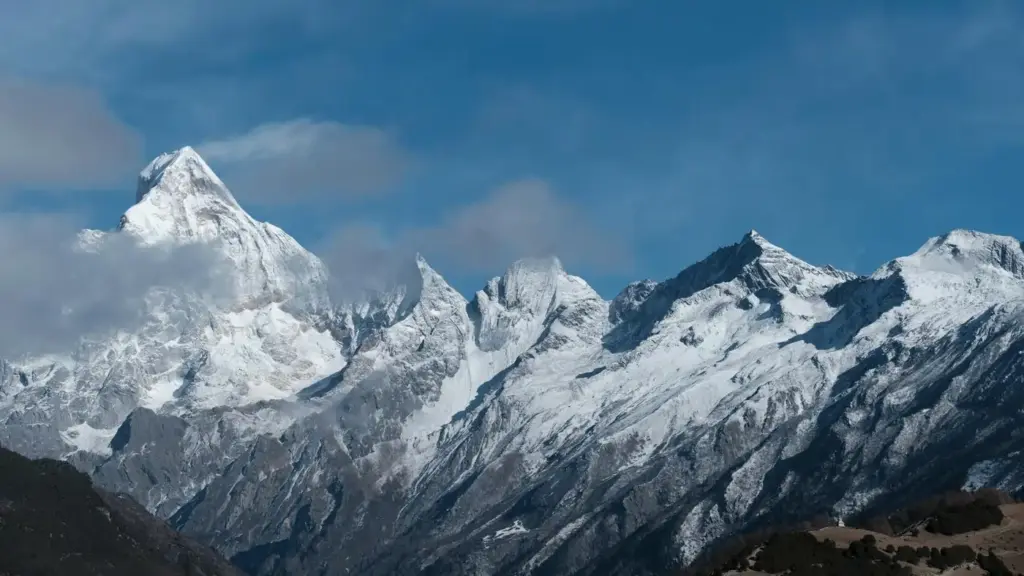
About Siguniang Mountain You Need to Know
Where is Siguniang Mountain?
Siguniang Mountain is located in the town of Siguniang Mountain in western Sichuan Province, about 220 km (137 mi) northwest of Chengdu. It is located in the Aba Tibetan and Qiang Autonomous Prefecture of Sichuan Province, straddling the border of Xiaojin County and Wenchuan County. The mountain range is part of the Qionglai Mountain Range, which is a transition zone between the Qinghai-Tibet Plateau and the Sichuan Basin.
It takes effort to get here, but that’s part of the reason it remains so pristine. Most tourists use Chengdu as their gateway city because it has an international airport that connects to major Asian hubs.
Tips: Chengdu is the capital of Sichuan Province and one of the first cities in China to have an international airport.
Why do people love Siguniang Mountain?
Siguniang Mountain offers an unmatched combination of dramatic natural beauty, cultural richness, and adventure opportunities. Unlike many remote mountain regions, these extraordinary landscapes—featuring jagged 6,000-meter peaks, crystal alpine lakes, ancient forests, and wildflower-carpeted meadows—can be reached within a day from a major international airport. The area’s living Tibetan and Qiang cultures add an authentic human dimension to the natural splendor, with prayer flags, traditional herders, and village festivals creating memories as powerful as the mountain scenery itself.
Visitors to Siguniang Mountain can enjoy activities catering to every interest and ability level, making it ideal for groups with varying preferences:
- Casual nature enthusiasts can enjoy boardwalk strolls with spectacular views
- Photographers find endless compositions in ever-changing mountain light
- Hikers discover trails ranging from gentle meadow walks to challenging alpine routes
- Climbers access everything from beginner-friendly peaks to serious mountaineering objectives
Which four peaks are Siguniang Mountain?
The mountain range features four distinct peaks standing in a row, resembling four sisters of different heights:
| Peak Name | Translation | Height | Difficulty |
| Dafeng | First Sister/Big Sister | 5,025m (16,486 ft) | Trekking (non-technical) |
| Erfeng | Second Sister | 5,276m (17,310 ft) | Basic climbing skills required |
| Sanfeng | Third Sister | 5,355m (17,569 ft) | Technical climbing |
| Yaomei | Fourth/Youngest Sister | 6,250m (20,510 ft) | Technical mountaineering |
Yaomei Peak deserves special mention – it’s the highest peak in western Sichuan and the easternmost 6,000m+ mountain in the world. Mountaineers consider it one of China’s most challenging climbs.
What are the routes/valleys to Mount Siguniang?
The mountain area is divided into three main valleys, which also represent three main routes. Each valley/route has its own characteristics:
Shuangqiao Valley (Double Bridge Valley) The most accessible and developed valley, featuring excellent infrastructure including plank roads and tourist shuttles. This valley is famous for its colorful forests, alpine meadows, and crystal lakes – a photographer’s dream.
Changping Valley (Long Plain Valley) A more rugged experience featuring pristine forests, streams, and traditional Tibetan villages. The valley leads toward Dafeng and Erfeng, making it popular with trekkers and climbers seeking these peaks.
Haizi Valley (Lakes Valley) The most remote and challenging valley, characterized by numerous alpine lakes (haizi means “lake” in Chinese) and high mountain meadows. This serves as the base camp area for climbing expeditions to the major peaks, particularly Yaomei.
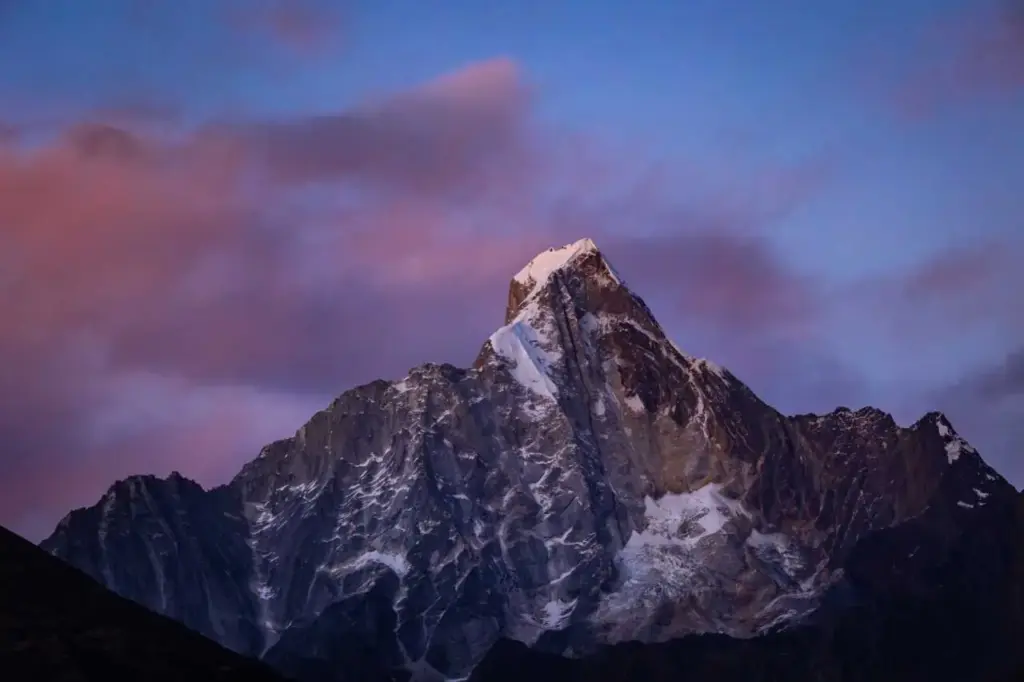
What is the climate and best time to travel to Mount Siguniang?
Siguniang Mountain has a typical highland climate with dramatic temperature swings between day and night. Conditions vary significantly by season:
Spring (April-June): Flowers bloom across alpine meadows. Weather becomes increasingly stable, though afternoon rain is common.
Summer (July-August): The warmest period with daytime temperatures reaching 20°C (68°F) in the valleys, but dropping to near freezing at night. This is the rainy season, with afternoon thunderstorms common.
Fall (September-November): The ideal season. Clear blue skies, stable weather, and stunning fall colors make this the perfect time for photography and trekking. Late September through early November offers the best visibility.
Winter (December-March): Extremely cold with heavy snow at higher elevations. Most facilities close, though some adventurous souls visit for ice climbing and winter photography.
For most visitors, late September to early November represents the sweet spot – comfortable temperatures, minimal precipitation, and excellent visibility for both photography and mountain activities.
How to Get to Siguniang Mountain?
To go to Mount Siguniang, you must first arrive in Chengdu, China. Chengdu is the capital of Sichuan Province and is famous for its pandas. It has a developed economy and an international airport. You have two main options for the journey from Chengdu to Siguniang Mountain Town (formerly called Rilong):
1. Private Car/Driver
- Travel time: 4-5 hours (depending on traffic and weather)
- Cost: 600-800 RMB one-way ($85-115)
- Pros: Flexible schedule, can stop at scenic spots, direct service
Contact us and we will help you reserve a vehicle, guaranteeing comfort and freedom.
2. Public Bus
- Travel time: 6-8 hours (including stops)
- Cost: 70-100 RMB one-way ($10-15)
- Departure: Chadianzi Bus Station in Chengdu
- Schedule: Morning departures (typically between the hours of 6-8 AM)
Note: Service availability can change seasonally.
3. Register through a travel agency
- Cost: 1,500-4,000 RMB ($215-570) for a 3-day package
- Includes: Transportation, accommodation, tickets, guides, and some meals
- Pros: Convenient for international visitors, overcomes language barriers
- Best for: First-time visitors, those unfamiliar with Chinese travel logistics
Contact us to book a customized Siguniang Mountain package that fits your schedule and interests.
What Should You Wear and Bring Go to Mount Siguniang?
Mount Siguniang is a high altitude area, so you need to pack your luggage carefully. Here are the items you need to prepare.
Clothing
A proper layering approach works best in mountain environments. Pack moisture-wicking base layers, insulating mid layers (fleece or down), and a waterproof/windproof outer shell. Include both hiking pants and shorts, appropriate headwear, and gloves suitable for the season.
Footwear
Sturdy hiking boots with good ankle support are essential, preferably well broken-in before your trip. Lightweight camp shoes provide welcome relief in the evenings.
Sun Protection
At high altitude, UV radiation intensifies dramatically. Bring high SPF sunscreen, lip balm with SPF, and quality sunglasses with UV protection. A buff or neck gaiter offers additional versatile protection.
Other
- Headlamp with extra batteries
- Water bottles (minimum 2 liters capacity)
- Basic first aid kit with blister treatment
- Trekking poles for steep terrain
- Toilet paper and hand sanitizer
- Some portable food
Tips: Most basic items such as food can be purchased in Siguniang Mountain Town. You only need to bring some clothes and sunscreen for hiking.
Where to Stay at Siguniang Mountain?
Built specifically for Mount Siguniang, the Siguniang Mountain Town (formerly known as Rilong) offers a range of accommodation options.
| Accommodation Type | Price Range (RMB) | Features |
| Luxury B&Bs | 600-1200 ($85-170) | Tibetan design, mountain views, English service |
| Mid-range Hotels | 300-600 ($40-85) | Basic amenities, heated rooms, simple restaurants |
| Budget Options | 50-150 ($7-22) | Dorm beds or basic private rooms, limited English |
You can contact us and we will help you book accommodation or book accommodation through a travel agency or platform such as Ctrip, or you can directly find the phone number on the map to contact the hotel.
How to Choose Among the Three Valleys of Siguniang Mountain
Each valley offers a unique experience based on your interests, fitness level, and time available. Understanding the key differences will help you make the best choice for your trip.
Shuangqiao Valley (Double Bridge Valley) – Perfect for First-Time Visitors
Shuangqiao Valley is the most accessible and developed option, featuring wooden boardwalks and a convenient shuttle service. With an entrance fee of 80 RMB plus a mandatory 70 RMB shuttle, this valley can be fully explored in one day and presents an easy to moderate difficulty level.
The valley showcases spectacular landscapes with minimal physical effort, making it suitable for visitors of all ages and fitness levels. Key highlights include:
- Rhinoceros Lake – Perfect for morning photography with mountain reflections
- Four Girls Lake – Beautiful alpine lake surrounded by meadows
- Sun-Moon Mirror Mountain – Distinctive geological formation with great photo opportunities
This valley is ideal for photography enthusiasts, families, and those with limited time or affected by altitude.
Changping Valley (Long Plain Valley) – For the Nature Enthusiast
Changping Valley offers a more immersive natural experience with fewer tourists and genuine wilderness encounters. The valley stretches 29km one-way with an entrance fee of 70 RMB. Unlike Shuangqiao, there’s no shuttle service—exploration is on foot or horseback, requiring a full day for partial exploration or 2-3 days to reach the end.
This valley serves as the main route to Dafeng and Erfeng mountains, following a river through pristine forests before opening into spectacular alpine meadows. The valley’s highlights unfold progressively as you hike deeper:
- Initial Forest Section (first 5km) – Easy walking through dense woodland with crystal-clear streams
- Muluozi Viewing Platform (13km from entrance) – Many day-hikers make this their turnaround point (5-hour round trip)
- Alpine Meadows (beyond Muluozi) – Perfect pastoral scenes with grazing yaks and seasonal wildflowers
The valley is also where you’ll encounter more authentic Tibetan culture, with opportunities to meet traditional herders and possibly arrange homestays in small settlements. Remember that Changping Valley has no food services, so bring all necessary supplies.
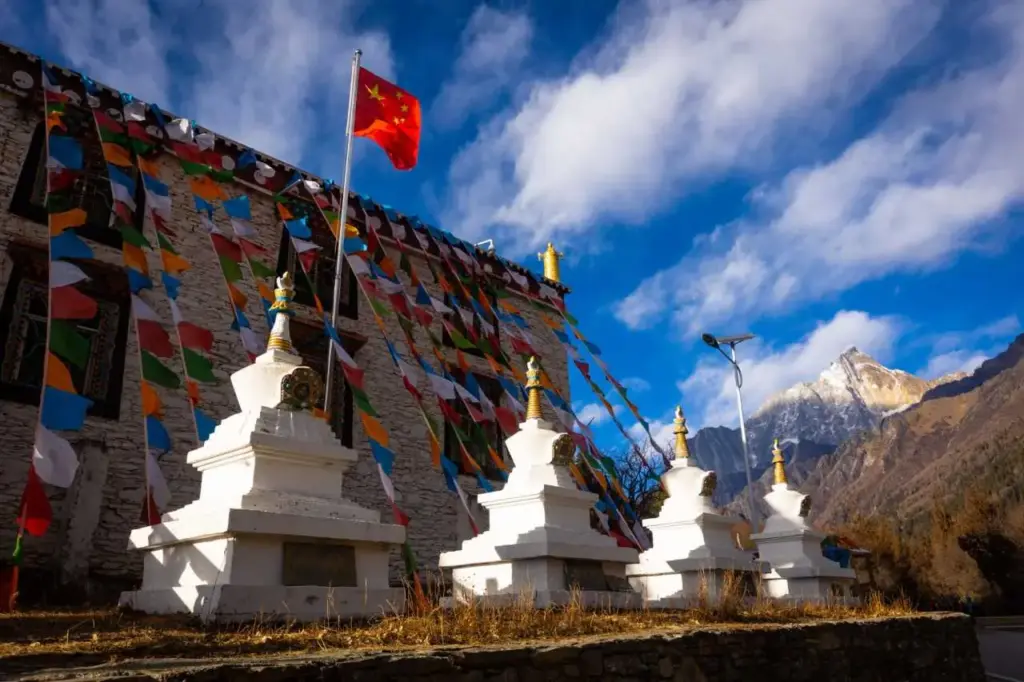
Haizi Valley (Lakes Valley) – For the Adventurous
Haizi Valley represents the most challenging and remote option, rewarding adventurous travelers with extraordinary alpine scenery and solitude. The trail extends 18km to the main lake area and requires at least two days with an overnight stay. The entrance fee is 70 RMB, and there are no facilities beyond the entrance.
The valley is named for its numerous alpine lakes, which reflect the surrounding peaks on clear days. The trail begins with a steep forest ascent, eventually giving way to alpine terrain of rock and meadow. After a challenging day’s hike, you’ll reach the main lake area at about 4,500m elevation, which serves as the base camp for mountaineering expeditions.
Notable features include:
- Five-Color Lake – A stunning alpine lake that changes hue throughout the day
- Amphitheater Viewpoint – Natural rock formation offering panoramic vistas
- Potential wildlife sightings including blue sheep and various alpine birds
The valley experiences extreme weather conditions even in summer, making it suitable only for experienced hikers prepared for remote wilderness conditions.
How to Choose the Right Valley for You
Choose Shuangqiao Valley if you have limited time, are traveling with children or elderly companions, want the most comfortable sightseeing experience, or are concerned about altitude adaptation. This valley is also perfect if photography is your primary interest.
Choose Changping Valley if you want a balance of accessibility and wilderness, enjoy forest and meadow landscapes, or are interested in Tibetan culture encounters. This valley is ideal for those with moderate hiking experience who want to escape the more touristy areas.
Choose Haizi Valley if you’re an experienced hiker comfortable with remote terrain, have at least 2-3 days available, and want maximum solitude in pristine natural settings. This valley requires proper preparation for high-altitude camping and is the starting point for climbing Yaomei Peak.
For visitors staying 3+ days, consider combining Shuangqiao Valley on day one (for acclimatization) followed by one of the other valleys. This approach allows you to enjoy both the accessible highlights and more authentic wilderness experiences.
Food and Culture of Siguniang Mountain
Siguniang Mountain region offers a unique cultural experience blending Tibetan and Qiang traditions. The local cuisine features hearty mountain fare that fuels trekkers and showcases regional flavors.
What local food can you try in Siguniang Mountain?
The food around Siguniang Mountain combines Tibetan, Qiang, and Sichuan influences. Don’t miss the signature yak meat hot pot, featuring thinly sliced meat in spiced broth with local herbs. Other specialties include highland barley bread, butter tea, dried yak jerky, and Tibetan momos (dumplings filled with yak meat, potatoes, or cheese).
Most restaurants in town feature these local dishes, with the most authentic experiences often found in smaller family-run establishments. Many guesthouses offer half-board options including breakfast and dinner with local dishes—convenient for hikers who will be out on trails during lunch.
What cultural experiences await you in Siguniang?
The valleys surrounding Siguniang Mountain have been home to Tibetan herders for generations. You’ll notice distinctive architecture with colorful window frames and prayer flags throughout the region. The town hosts a small monastery that welcomes respectful visitors outside prayer times.
If your timing allows, experiencing a local festival provides unforgettable cultural insights. The Mountain God Festival (usually May/June) is the most important local celebration, featuring offerings to mountain deities, traditional costumes, music, and dancing. Other notable events include Tibetan New Year (February/March) and summer horse racing competitions (July/August).
When interacting with local communities, remember to show respect for religious sites by walking clockwise around structures and never stepping over prayer flags. Always ask permission before photographing local people, especially during religious activities.
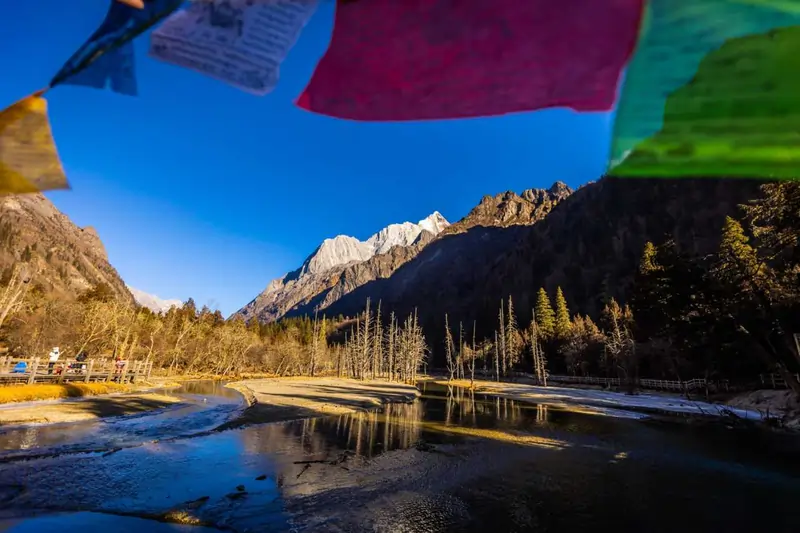
Practical Tips
Money Matters
The Chinese Yuan (RMB) is the only accepted currency in the Siguniang Mountain area. While major hotels accept credit cards, most smaller establishments only take cash. ATMs are available in town but can be unreliable, so bring sufficient cash from Chengdu. Digital payments through WeChat Pay and Alipay are common but typically require Chinese bank accounts.
Cost expectations:
- Entrance fees: 70-80 RMB per valley
- Meals: 30-50 RMB (basic), 80-150 RMB (mid-range dinner)
- Accommodation: 150-250 RMB (budget), 300-600 RMB (mid-range)
- Services: 400-600 RMB (local guide per day), 300-500 RMB (horse rental half day)
Communication
Cell coverage is reliable in town (China Mobile offers the strongest signal) with some service in Shuangqiao Valley, but limited to no coverage in Changping and Haizi Valleys. Most accommodations offer WiFi with varying speeds. Remember that a VPN is needed to access services like Google, WhatsApp, and Facebook.
Language considerations:
- English is limited outside major hotels and tour companies
- Translation apps are helpful (download offline packages before your trip)
- Learn basic Chinese phrases for emergencies and common needs
- Visual communication often works well
Useful apps include Baidu Maps (works without VPN), Pleco (Chinese-English dictionary), WeChat, and Maps.me (download offline maps before arrival).
Health and Safety Concerns
Medical facilities are limited with no major hospitals in town—the closest full-service facility is in Chengdu. The local clinic can handle basic issues and initial altitude treatment. Bring personal medications plus basics like painkillers, altitude medication, and stomach remedies.
Common health issues include:
- Altitude sickness (symptoms include headache, nausea, dizziness)
- Sunburn from intense UV radiation at high elevations
- Dehydration due to dry mountain air
- Stomach issues from varying water quality
- Minor injuries from rough trails
For serious emergencies, evacuation to Chengdu is necessary. Standard emergency numbers in China are 120 (medical) and 110 (police). Consider renting a satellite phone for remote treks where cell service is unavailable, and always register with your country’s embassy before remote travel.
Conclusion
Siguniang Mountain offers spectacular experiences for all travelers. With three valleys, various accommodations, and activities from easy walks to challenging climbs, this “Oriental Alps” destination creates unforgettable memories.
Proper preparation is essential—understand each valley, plan for altitude, and choose the right season. Whether traveling independently or with guides, the stunning landscapes and authentic cultural encounters make the journey worthwhile.
Common FAQs
Do I need a guide for Siguniang Mountain?
Shuangqiao Valley: No. Changping Valley: Recommended but optional for experienced hikers. Haizi Valley and all peak climbing: Yes, required for safety and regulations.
How difficult is hiking in Siguniang Mountain?
Shuangqiao Valley: Easy, suitable for all fitness levels. Changping Valley: Moderate, requires basic hiking experience. Haizi Valley: Challenging, demands good fitness and high-altitude experience.
Is there clean drinking water at Siguniang Mountain?
Town water needs boiling/treatment. Hotels and restaurants provide safe boiled water. Always treat mountain stream water before drinking.
What should I know about toilets at Siguniang Mountain?
Western toilets in town hotels/restaurants. Basic facilities at valley entrances. Very limited on trails – bring toilet paper and pack out waste.
Is Siguniang Mountain safe for tourists?
Yes, crime rates are very low. Solo travelers, including women, report feeling safe. The main risks are wilderness/altitude-related, not security concerns.
Can foreigners use credit cards at Siguniang Mountain?
Major hotels accept international cards. Most restaurants and shops are cash-only. Bring sufficient RMB cash from Chengdu.
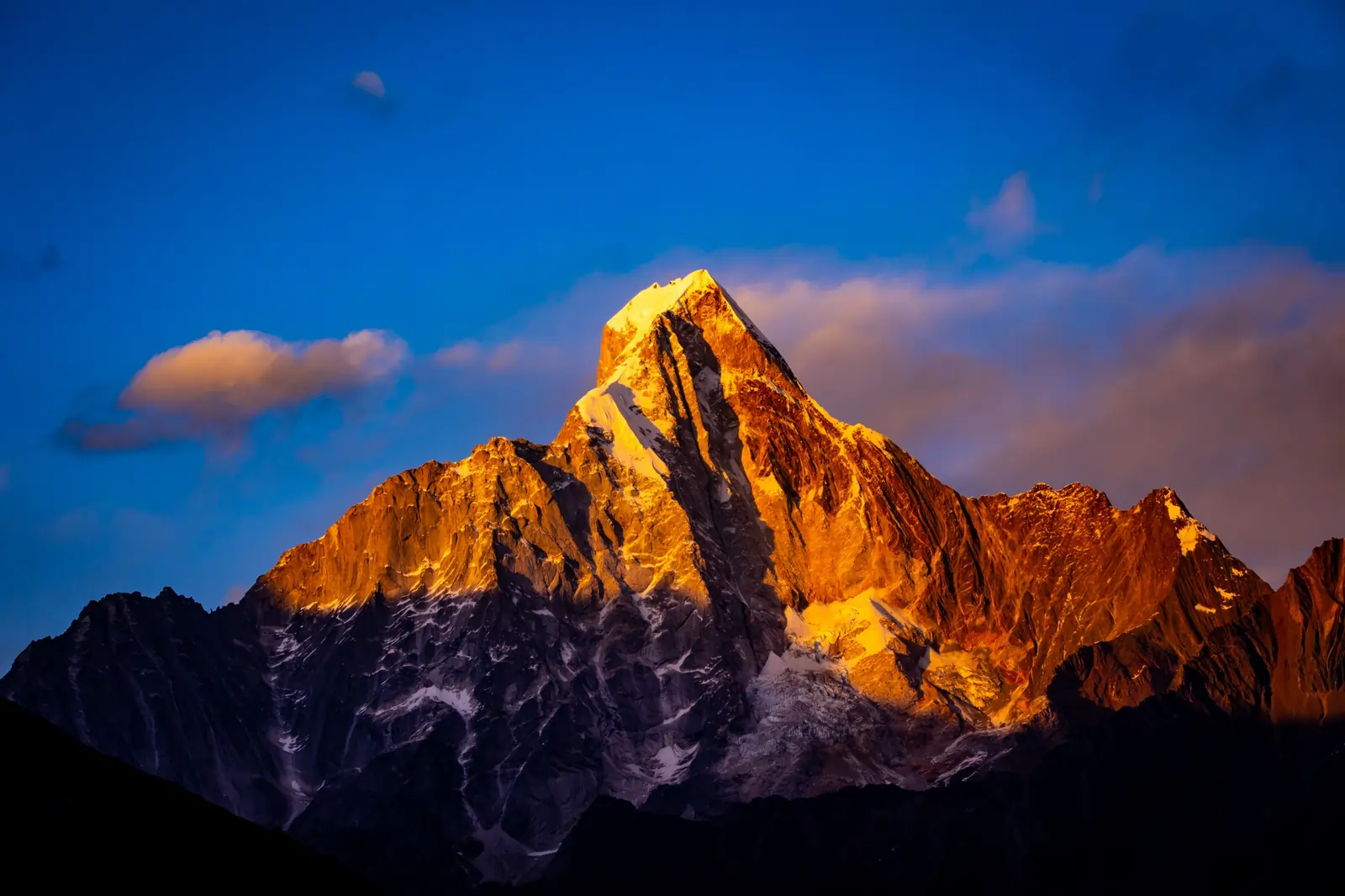
Leave a Reply